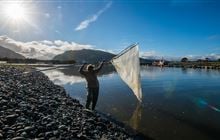Protecting the whitebait fishery for future generations
Archived content: This media release was accurate on the date of publication.
Introduction
Changes to whitebaiting regulations will improve the sustainability of threatened species, while ensuring that Kiwis can continue the tradition of catching a feed in their local river into the future, Acting Conservation Minister Dr Ayesha Verrall says.Date: 02 June 2021 Source: Office of the Acting Minister of Conservation | Minita Taupua mō Te Papa Atawhai
Whitebait are a valuable part of the indigenous biodiversity of Aotearoa, and are taonga and mahinga kai for Māori,” Ayesha Verrall said.
“However, four of the six whitebait species are threatened or at risk of extinction. While fishing pressure is a contributing factor, habitat loss, environmental degradation, impeded fish passage within river systems, loss of spawning sites and introduced fish species are also impacting whitebait numbers.
“Whitebait regulations haven’t been reviewed since the 1990s, and changes are long overdue. We want to ensure the whitebait fishery survives and thrives, for all New Zealanders, while maintaining long-held traditions and encouraging responsible fishing practices,” Ayesha Verrall said.
The planned changes fit with the Government’s manifesto commitment to protect, preserve and restore our natural heritage and biodiversity. They address identified issues and focus on practicality and common sense and follow two years of engagement, including consultation on proposed regulations which attracted over 11,500 submissions.
“The immediate impact on the majority of fishers will be minimal. People will still be using the same gear and fishing in the same places when the season opens.
“The changes that are being made will better align practices nationwide, improve the long-term sustainability of the fishery and support recreational, low volume fishers. They do not affect customary fishing rights.
“Two years of engagement on improving whitebait management, including the consultation on regulatory changes, has shown how passionate New Zealanders are about whitebait and the whitebait fishery.
“DOC has also been asked to gather more evidence about the state of the whitebait fishery, including further monitoring, scientific assessment and economic analysis. Better information is essential to ensure the whitebait management programme is effective and any need for further changes to the programme or regulations are identified.
“Work will continue on improving spawning sites, ensuring that national rules recognise fish needs, partnering with mana whenua, and working closely with whitebaiters, conservation groups and others with an interest in whitebait,” Dr Ayesha Verrall said.
Changes will be phased in over three seasons, to assist with practical implementation on the ground, as those affected adjust to new practices.
2021 season, changes will include:
- Fishing will be prohibited within 20 metres of structures such as weirs and groynes where fish congregate.
- Screens will be the only lawful diversion device and limited to three metre maximum length.
- The rule that only one net can be used when fishing from a stand, will be extended to all of New Zealand.
- The maximum incursion of fishing gear (excluding stands) into a waterway, will be one-quarter of its width, nationwide.
- The minimum fixed distance between fixed fishing gear (not stands) will be 20 metres.
- Fishing can only occur in estuaries and near river mouths nationwide. This is already the case on the West Coast.
- More whitebait refuges in waterbodies that flow out of Abel Tasman and Fiordland national parks will help to protect whitebait populations, similar to whitebait refuges already in place on the West Coast.
- The proposal is to extend the current exclusion in place from Yates Point to Puysegur Point, to also include the South Coast as far as Waitutu River mouth. Martins Bay (even though it is within Fiordland National Park) is not being proposed as a refuge.
2022 season, changes will include:
- The season to shorten to 1 Sept – 30 October for all New Zealand
2023 season, changes will include:
- Overall length limit for fishing gear of six metres for all New Zealand
Contact
For media enquiries contact:
Email: media@doc.govt.nz

